Related Research Articles

Yosemite Sam is a cartoon character in the Looney Tunes and Merrie Melodies series of short films produced by Warner Bros. His name is taken from Yosemite National Park in California. He is an adversary of Bugs Bunny and his archenemy alongside Elmer Fudd. He is commonly depicted as a mean-spirited and extremely aggressive, gunslinging outlaw or cowboy with a hair-trigger temper and an intense hatred of rabbits, Bugs in particular. In cartoons with non-Western themes, he uses various aliases, including "Chilkoot Sam" and "Square-deal Sam" in 14 Carrot Rabbit, "Riff Raff Sam" in Sahara Hare, "Sam Schultz" in Big House Bunny, "Seagoin' Sam" in Buccaneer Bunny, "Shanghai Sam" in Mutiny on the Bunny, "Von Schamm the Hessian" in Bunker Hill Bunny, "Baron Sam von Schpamm" in Dumb Patrol, and many others. During the golden age of American animation, Yosemite Sam appeared as antagonist in 33 animated shorts made between 1945 and 1964.
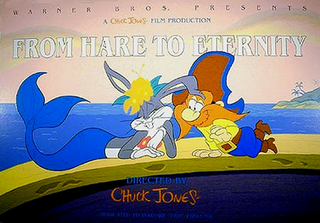
From Hare to Eternity is a Looney Tunes cartoon directed by Chuck Jones released on November 4, 1997.
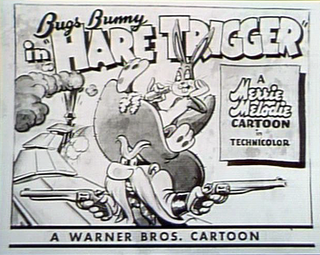
Hare Trigger is a 1945 Merrie Melodies cartoon directed by Friz Freleng. The cartoon was released on May 5, 1945, and features Bugs Bunny. The short featured the first appearance of Yosemite Sam, as well as the first short to credit (almost) the whole animation staff who worked on the short.

Looney Tunes Golden Collection: Volume 1 is a DVD box set that was released by Warner Home Video on October 28, 2003. The first release of the Looney Tunes Golden Collection DVD series, it contains 56 Looney Tunes and Merrie Melodies cartoons and numerous supplements. The set won the Classic Award at the Parents' Choice Awards.
High Diving Hare is a 1948-produced Warner Brothers Looney Tunes theatrical cartoon short starring Bugs Bunny and Yosemite Sam. Released to theaters on April 30, 1949, the short is an expansion of a gag from Stage Door Cartoon, which was also directed by Friz Freleng, and co-stars Elmer Fudd. High Diving Hare can be seen in the third act of The Looney Looney Looney Bugs Bunny Movie, and a segment can be seen in the special Bugs Bunny's Wild World of Sports.

Hair-Raising Hare is a Warner Bros. Merrie Melodies cartoon, released on May 25, 1946. It was directed by Chuck Jones and written by Tedd Pierce. It stars Bugs Bunny and features the first appearance of Chuck Jones' orange monster character "Gossamer".
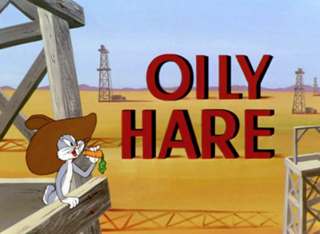
Oily Hare is a 1952 Warner Bros. Merrie Melodies animated short directed by Robert McKimson and written by Tedd Pierce. The short was released on July 26, 1952, and stars Bugs Bunny.
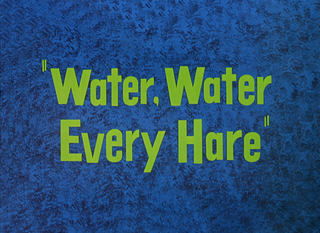
Water, Water Every Hare is a 1952 Warner Bros. Looney Tunes cartoon directed by Chuck Jones. The cartoon was released on April 19, 1952 and stars Bugs Bunny. The short is a return to the themes of the 1946 cartoon Hair-Raising Hare and brings the monster Gossamer back to the screen.

Buccaneer Bunny is a 1948 Looney Tunes cartoon directed by Friz Freleng. The short was released on May 8, 1948, and features Bugs Bunny and Yosemite Sam.
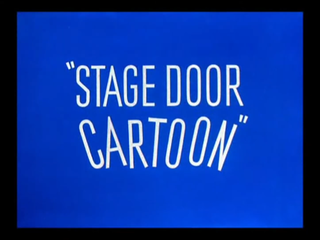
Stage Door Cartoon is a 1944 Merrie Melodies cartoon directed by Friz Freleng. The short was released on December 30, 1944, and features Bugs Bunny and Elmer Fudd.
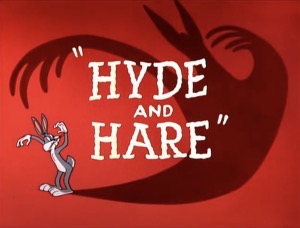
Hyde and Hare is a 1955 Warner Bros. Looney Tunes cartoon, directed by Friz Freleng. The short was released on August 27, 1955, and stars Bugs Bunny. The short is based on Robert Louis Stevenson's 1886 novella Strange Case of Dr Jekyll and Mr Hyde. The cartoon pits Bugs against Dr. Jekyll, who continues to turn into Mr. Hyde. The title is a play on the expression "neither hide nor hair."

Sahara Hare is a 1955 Warner Bros. Looney Tunes theatrical cartoon short directed by Friz Freleng. The short was released on March 26, 1955, and stars Bugs Bunny and Yosemite Sam.

Hare and Loathing in Las Vegas is a 2004 Bugs Bunny cartoon short, which co-starred Yosemite Sam. It was directed by Peter Shin and Bill Kopp, and produced by Warner Bros. Animation.
Hare Lift is a 1952 Warner Bros. Looney Tunes short directed by Friz Freleng. The short was released on December 20, 1952, and stars Bugs Bunny and Yosemite Sam. The title is a play on the term "air lift," as expressed in the plotline.

Rabbit Every Monday is a 1951 Warner Bros. Looney Tunes cartoon directed by Friz Freleng. The short was released on February 10, 1951, and stars Bugs Bunny and Yosemite Sam. The title is a play on Chicken Every Sunday.

A Star Is Bored is a 1956 Warner Bros. Looney Tunes cartoon, directed by Friz Freleng. The short was released on September 15, 1956, and stars Bugs Bunny and Daffy Duck. The cartoon expands upon the rivalry depicted between Bugs and Daffy, in such films as Chuck Jones' 1951 short Rabbit Fire, this time placing the action in a show-biz setting. In this 7-minute short, Daffy must double for Bugs in any slapstick that Warners deems too dangerous for its top star. After each disaster, Daffy shouts "MAKEUP!". The director directing the scenes has an Erich Von Stroheim accent.

Wild and Woolly Hare is a 1959 American animated Western comedy short film directed by Friz Freleng and written by Warren Foster. The short was released on August 1, 1959 by Warner Bros. Pictures as part of the Looney Tunes series, and features Bugs Bunny and Yosemite Sam.
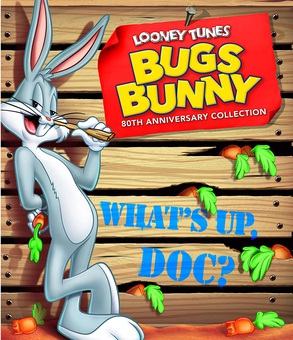
Looney Tunes: Bugs Bunny 80th Anniversary Collection is a Blu-ray Disc box-set released by Warner Bros. Home Entertainment on December 1, 2020. It contains 60 Looney Tunes and Merrie Melodies shorts starring Bugs Bunny and numerous bonus features and supplementary content. The set's packaging includes a slip book, a booklet, and a collectible Bugs Bunny Funko! POP doll.
References
- ↑ Beck, Jerry; Friedwald, Will (1989). Looney Tunes and Merrie Melodies: A Complete Illustrated Guide to the Warner Bros. Cartoons. Henry Holt and Co. p. 222. ISBN 0-8050-0894-2.
- ↑ Lenburg, Jeff (1999). The Encyclopedia of Animated Cartoons. Checkmark Books. pp. 60–61. ISBN 0-8160-3831-7 . Retrieved 6 June 2020.